

Asian Men. Renaissance. British Men. European Men. Medicinal Botany. Religious. South Carolina. War. Women. The Linnean Society of London in Burlington House. Written in Petals - Online exhibitions across Cornell University Library. White lilies for grief.

Snowdrops for hope. Daisies for innocence. Red roses for love, yellow for friendship. Three Black Scientists Overlooked by History – Discover + Share. Though often overlooked by historians, several Black scientists are among the most spectacular contributors to horticulture and agricultural history.

Faced with unique but extraordinary challenges, Percy Julian, Marie Clark Taylor, and Edmond Albius all contributed significantly to botany, horticulture, and humankind through their experimentation and exploration with plants. British History Online makes all research content free to individual users - On History. From the BHO editorial team British History Online (BHO) is a digital collection of key printed primary and secondary sources for the history of Britain and Ireland, with a special focus on the period 1300 to 1800.
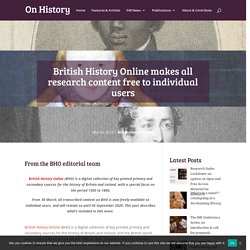
From 30 March, all transcribed content on BHO is now freely available to individual users, and will remain so until 30 September 2020. This post describes what’s included in this move. #DLFMuseums: Decolonizing Botanical Catalogs. Biographies of Putnam Museum Herbarium Collectors. Adams, Robert P. (1886-1944) Robert Perry Adams (from Solon, Iowa) earned the Bachelor of Science degree from the University of Iowa in 1908 (Sabin et al. 1913) and was pursuing the Master of Science degree from the same institution in 1927 under the guidance of Prof.
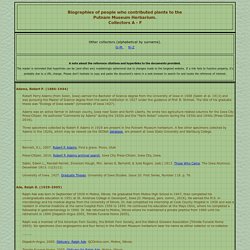
B. Shimek. The title of his graduate thesis was "Ecology of Iowa weeds" (University of Iowa 1927). Adams was an active farmer in Johnson county, Iowa near Solon and North Liberty. Three specimens collected by Robert P. Data - Data Portal. ESSAY ON THE HISTORY OF STUDY OF FORESTS OF THE CENTRAL CISCAUCASIA – тема научной статьи по биологии читайте бесплатно текст научно-исследовательской работы в электронной библиотеке КиберЛенинка. Original Russian Text © 2019 N.E.
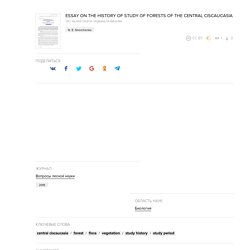
Shevchenko, published in Forest Science Issues Vol. 2, No. 1, pp. 1-26 DOI 10.31509/2658-607x-2019-2-2-1-18 ESSAY ON THE HISTORY OF STUDY OF FORESTS OF THE CENTRAL CISCAUCASIA N.E. Shevchenko Center for Forest Ecology and Productivity of the RAS Profsoyuznaya st. 84/32 bldg. 14, Moscow, 117997, Russia E-mail: neshevchenko@gmail.com Received 19 February 2019. Global Plants Initiative (GPI) Kew. Bartram Unearthing a botanical legacy, one seed at a time. Short history of biology after the middle ages. After the capture of Constantinople by the Turks These pages are protected by copyright: Antoine Danchin © 2000 - 2019 & Disclaimer.
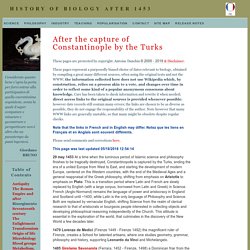
These pages represent a purposedly biased choice of dates relevant to biology, obtained by compiling a great many different sources, often using the original texts and not the WWW; the information collected here does not use Wikipedia which, by construction, relies on a process akin to a vote, and changes over time in order to reflect some kind of a popular anonymous consensus about knowledge. Care has been taken to check information and rewrite it when needed; direct access links to the original sources is provided whenever possible; however date records still contain many errors; the links are chosen to be as diverse as possible, they do not engage the responsability of the author.
Note however that many WWW links are generally unstable, so that many might be obsolete despite regular checks. Slavery and the British Country House – Free download. The British country house has long been regarded as the jewel in the nation's heritage crown.
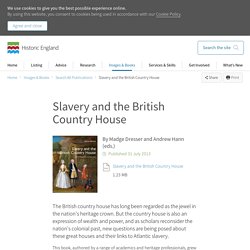
But the country house is also an expression of wealth and power, and as scholars reconsider the nation's colonial past, new questions are being posed about these great houses and their links to Atlantic slavery. Alfred Waterhouse, the affable artist, and the Natural History Museum. ANH Virtual Issues. Home - Making Visible: The visual and graphic practices of the early Royal Society. 14 Purdie Collections & collectors final 6Jul18. Designation Identifier : Handwriting. The Top 10 ‘first’ botanic gardens. How the invention of paper changed the world. Image copyright Getty Images The Gutenberg printing press - invented in the 1440s by Johannes Gutenberg, a goldsmith from Mainz in Germany - is widely considered to be one of humanity's defining inventions.
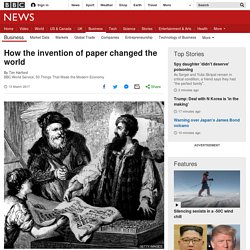
Gutenberg figured out how to make large quantities of durable metal type and how to fix that type firmly enough to print hundreds of copies of a page, yet flexibly enough that the type could be reused to print an entirely different page. His famous bibles were objects beautiful enough to rival the calligraphy of the monks. The crisp black Latin script is perfectly composed into two dense blocks of text, occasionally highlighted with a flourish of red ink. Image copyright iStock Actually, you can quibble with Gutenberg's place in history. It is also not true that Gutenberg single-handedly created mass literacy. The Botany of Empire in the Long Eighteenth Century. The long eighteenth century saw widespread exploration and a tremendous increase in the traffic in botanical specimens.

The goal of many imperial expeditions was to explore the natural resources of colonies and distant lands in search of potentially profitable plants and products. Plants arrived at major cities on board ships, and were grown in botanical gardens that were often state-funded. The plants were studied and cultivated, especially if they were perceived to have economic or medicinal value. Visions of Latin American Nature, Tracing the roots – stems, leaves, fruits... – of modern botany « Botany One.
Ancient Botany.

Gavin Hardy and Laurence Totelin. Routledge, 2016. What do you get if you combine the academic interests of a marine phycologist with those of a member of the British Society for the History of Pharmacy? Mapping the Republic of Letters. Beautiful Science - Natural History Timeline. British Library: Botany in British India Material. BHL Valued by Historians. Many people tend to think of BHL as a resource for scientists.
While it’s true that scientists use BHL to find species descriptions and data about earth’s flora and fauna, they are not the exclusive beneficiaries of this wealth of knowledge. BHL contains more than half a millennia's worth of records about the discovery of life on our planet. It is valuable both for the raw data it provides and for the context and history it relates.
It is not just a repository of biodiversity information. It also captures the evolution of our understanding, appreciation, and interactions with the natural world. Dr. Botany in print: books and their readers in 18th-century Dublin. Elaine Ayers. I am a PhD candidate in Princeton's Program in the History of Science, broadly working on the intersections of aesthetics, exploration, and natural history in the eighteenth and nineteenth centuries in the British tropics. My dissertation follows four species of plants that confounded ideas of plant reproduction, troubled notions of floral beauty, and upset configurations of gender, sexuality, science, and empire. I'm especially interested in how plants were transported across oceans and figured as material objects in Victorian museums, herbaria, and gardens. My recent work can be found in The Public Domain Review and The Appendix. This semester you'll find me precepting in Princeton for Michael Gordin's undergraduate "Science in the Modern World" course and serving as Associate Director of the Behrman Society while living and writing in Philadelphia.
In spring 2015, I completed general examination fields in: Global 18th Century Textile Traditions & Trade. Textilia Linnaeana is an expedition in time and space. It is also a work of considerable interdisciplinary breadth. There is every reason to join the long textile journey. No equivalent representation is known to me. A Short History of the Seed and Nursery Catalogue in Europe and the U.S. History of Moss Research. "When I detect a beauty in any of the recesses of nature, I am reminded, by the serene and retired spirit in which it requires to be contemplated, of the inexpressible privacy of a life — how silent and unambitious it is.
The beauty there is in mosses must be considered from the holiest, quietest nook. " — Henry David Thoreau (1817–62). Mosses carpet my hillside backyard, a green expanse covering soil and wood. A fat robin, with nervous energy, hunts for bugs in rotten timbers, unfolding green mats with his beak. He is well aware that small insects hide in that green layer.
Frances Elizabeth Tripp (1832–90) noted in 1868 in her colorfully written Victorian tome entitled British Mosses, Their Homes, Aspects, Structure, and Uses: Gareth Evans's botanical & cultural histories. Beautiful Science: Ideas that Changed the World-Natural History. Spanish Botanical Expeditions to Latin America. Rare flowers discovered in Roman hoard. The Lost Jenks Museum of Natural History Makes a Brief Return to Brown University. The earliest recorded tomato in Britain, in Wales. Manchester Collectors. Charles Bailey (1838-1924) Bailey was born at Atherstone, Warwickshire on the 14th June 1838. Anna Svensson: Following Botanical Footsteps. This entry was posted on by Johan Gärdebo. Last May I attended the biennial Environmental History PhD Workshop at the Australian National University, Canberra – my very first trip to Australia.
This is a brief account of that trip (loosely) inspired by Sir George Wheler’s (1650-1723) A Journey into Greece (1682) with snippets from my travel journal. Plant exploration in post-Meiji Japan. New Book: Montana's Pioneer Botanists Description. Under Victorian Microscopes, an Enchanted World. The Accidental Invention of Terrariums. The terrarium was an accidental discovery in one of the most polluted parts of world. Wardian cases, as terrariums were originally known, were named after their inventor, Nathaniel Bagshaw Ward, an unsuccessful gardener in London’s East End in the late 1820s.